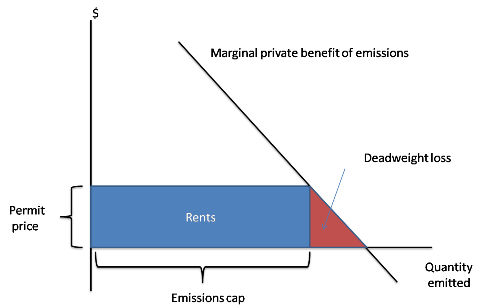Paul Krugman has a nice introduction to the textbook economics of cap and trade. Its well worth a read if you were wondering how an ETS is supposed to reduce greenhouse gas emissions by using the market. The key is this graph, showing the connection between the size of the cap and the price of emissions:

You should read the full article to get the proper explanation, because I want to use it to illustrate the effects of National's policy. Firstly, pretty much everything National has done - the production-based subsidies, which increase the permit supply in line with demand, the ban on overseas sales of non-forestry credit, the 50% obligation and $25 price cap until 2013 - is aimed at lowering the price. All other things being equal, this means more emissions than we would get under Labour's scheme. Secondly, National's massive ongoing subsidies mean that almost all of the blue area labelled "rents" - an amount equal to $1.7 billion over 2010 - 2012, and much more after that - is given away free to polluters. That's money we could be using for schools, hospitals, and trains; instead it goes straight into the pockets of Rio Tinto, Methanex, and Contact Energy - the very climate criminals who caused the problem in the first place.
Finally, Krugman has some harsh words for "free market" opponents of emissions trading:
what you should bear in mind is that all I’m doing here is conventional neoclassical economics, quite literally basic textbook material. What does it say when the people who claim to believe in this stuff throw it out the window as soon as it leads to policy conclusions they don’t like?What indeed? But I guess people like ACT and the Business Roundtable only believe in market economics when it suits them - i.e. when it benefits the rich.





